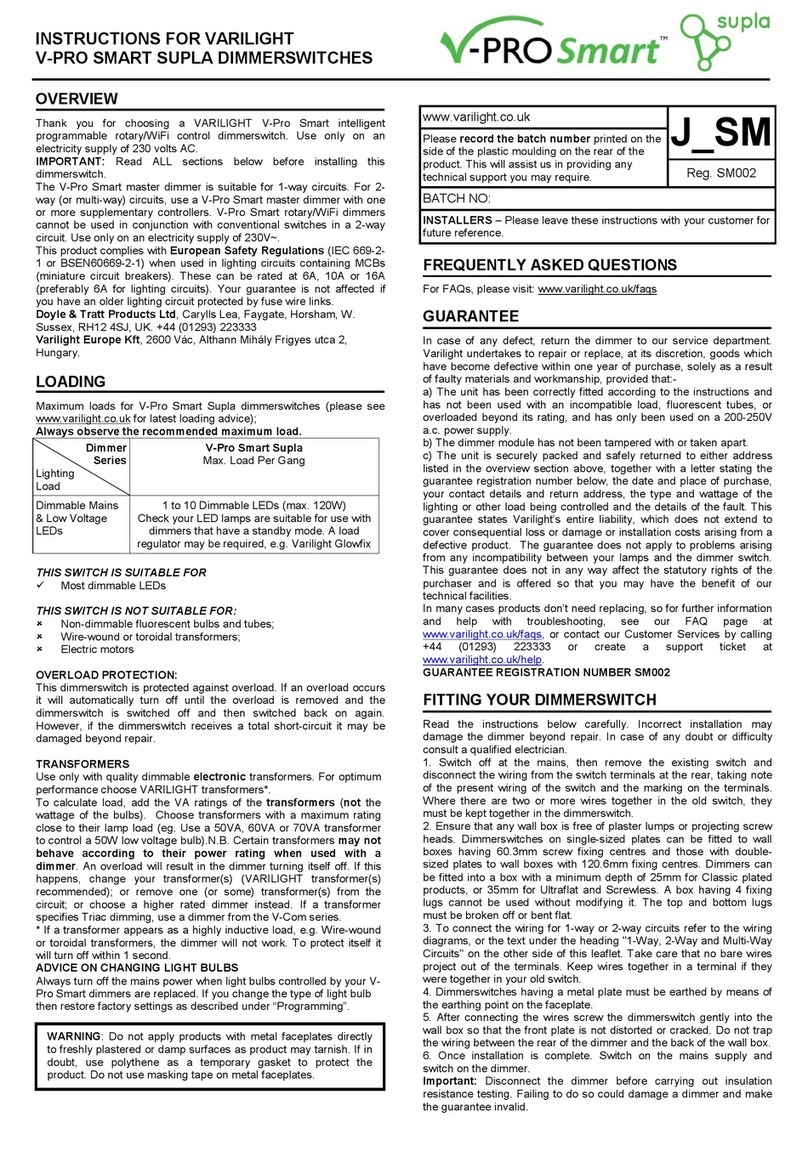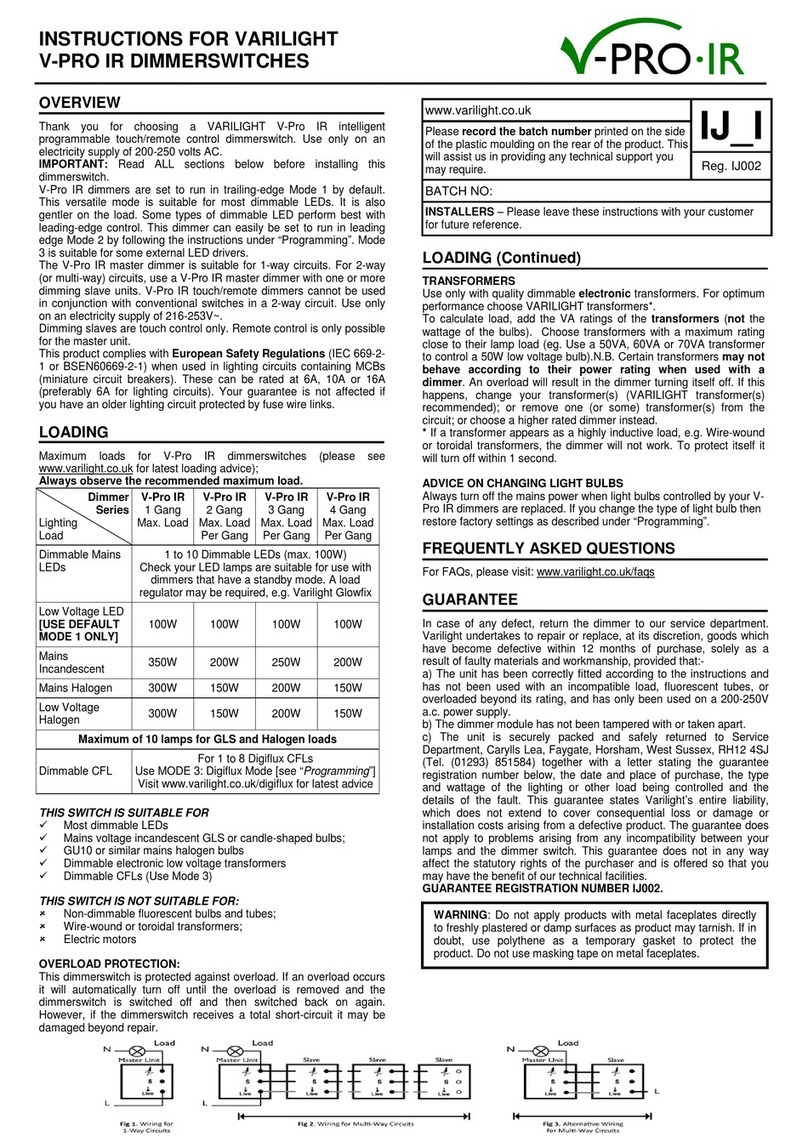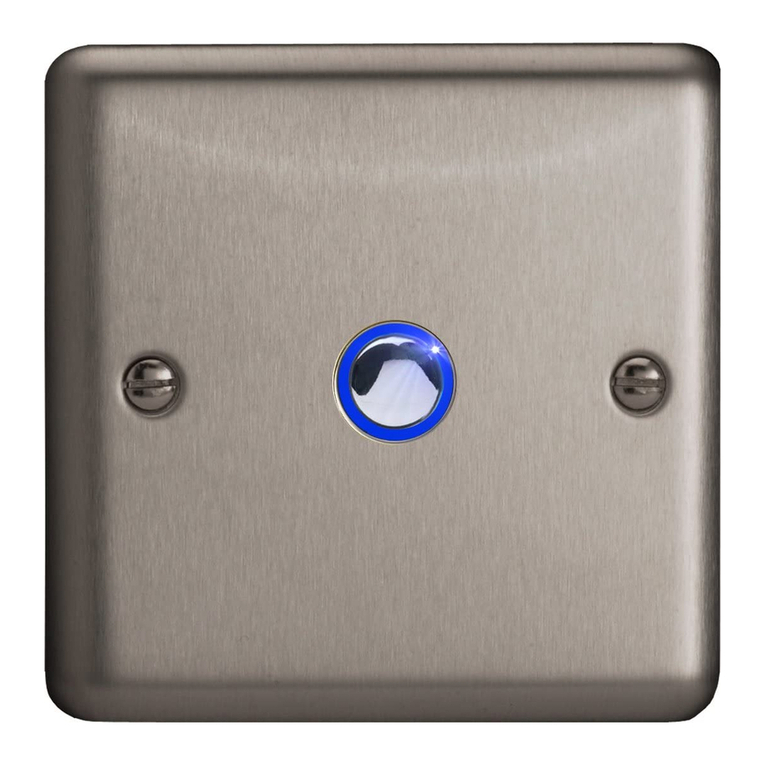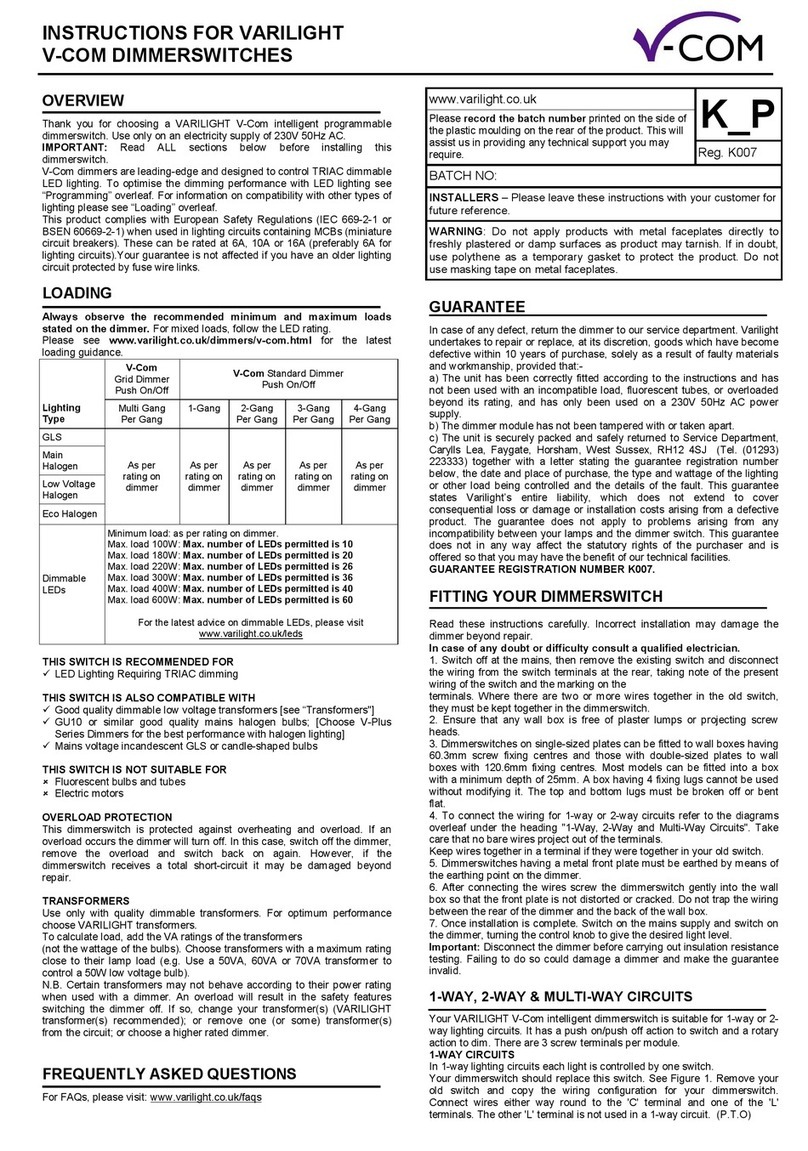
FITTING THE SWITCH
Read the instructions below carefully before beginning.
In case of any doubt or difficulty consult a qualified
electrician.
1. Switch off at the mains.
2. Remove the
existing switch and disconnect the wiring from
the switch terminals at the rear, taking note of the present
wiring of the switch and the marking on the terminals. Where
there are two or more wires together in the old switch they
must be kept together in the dimmer.
3.
Check that you have a genuine live feed as well as load
wire(s) at the wall box (see wiring diagrams below).
4.
Ensure that any wall box is free of plaster lumps or projecting
screw heads. Use a box with a minimum depth of 35mm for
touch/remote dim
mers in our Ultraflat and Screwless ranges.
For other ranges a box depth of 25mm is sufficient. Please
note, a box having 4 fixing lugs cannot be used without
modifying it. The top and bottom lugs must be broken off or
bent flat.
5. To connect the wiring, re
fer to the diagrams below. Dimmers
with a metal front plate must be earthed by means of the
earthing point on the dimmer. You must ensure that all wires
are sleeved fully and only enough bare wire is showing to
connect to the terminals. Push wires deep int
tighten terminal screws so that wires are held securely. No
bare wires should protrude from the terminals
6.
After connecting the wires, screw the dimmer gently into the
wall box. Do not trap the wiring between the rear of the
dimmer and the back of the wall box.
7. Turn on the mains electricity.
OPERATION OF THE SWITCH
To initialize the dimmer, touch the circular “sensor” on the front
of the plate once for 2 seconds. The dimmer will respond by
making the light(s) brighter. A single touch will
light(s) on or off. To dim the lights, keep contact with the sensor
until the desired light level is reached. While contact with the
sensor is maintained, the brightness will cycle up and down. To
change the direction of the dimming cycle, re
then touch the sensor again. When the brightness reaches the
level you require, remove contact with the sensor.
1-WAY, 2-WAY OR MULTI-
In 1-
way lighting circuits the light(s) are controlled by one switch.
This dimmer should
replace that switch. The live wire must be
connected to the terminal marked "Live
↓" and the "load" wire to
the terminal marked " ". [See Figure 1]
For 2-way or Multi-
way circuits (where the light(s) are controlled
by more than one switch) use this dimmer
VARILIGHTdimming slaves (total cable length from the master
to the last slave should be no more than 50m) following the
wiring d
iagrams below. It is not possible to use a conventional
switch in combination with this type of dimmer.
and 3]
To fit 2, 3 or 4-
gang dimmers treat each group of terminals at the
back of the unit as a separate dimmer, wiring them into the
lighting circuits as above. You may need a short length of wire to
connect together the "Live↓” terminals.
Read the instructions below carefully before beginning.
In case of any doubt or difficulty consult a qualified
existing switch and disconnect the wiring from
the switch terminals at the rear, taking note of the present
wiring of the switch and the marking on the terminals. Where
there are two or more wires together in the old switch they
Check that you have a genuine live feed as well as load
wire(s) at the wall box (see wiring diagrams below).
Ensure that any wall box is free of plaster lumps or projecting
screw heads. Use a box with a minimum depth of 35mm for
mers in our Ultraflat and Screwless ranges.
For other ranges a box depth of 25mm is sufficient. Please
note, a box having 4 fixing lugs cannot be used without
modifying it. The top and bottom lugs must be broken off or
fer to the diagrams below. Dimmers
with a metal front plate must be earthed by means of the
earthing point on the dimmer. You must ensure that all wires
are sleeved fully and only enough bare wire is showing to
tighten terminal screws so that wires are held securely. No
After connecting the wires, screw the dimmer gently into the
wall box. Do not trap the wiring between the rear of the
To initialize the dimmer, touch the circular “sensor” on the front
of the plate once for 2 seconds. The dimmer will respond by
light(s) on or off. To dim the lights, keep contact with the sensor
until the desired light level is reached. While contact with the
sensor is maintained, the brightness will cycle up and down. To
then touch the sensor again. When the brightness reaches the
way lighting circuits the light(s) are controlled by one switch.
replace that switch. The live wire must be
↓" and the "load" wire to
way circuits (where the light(s) are controlled
VARILIGHTdimming slaves (total cable length from the master
to the last slave should be no more than 50m) following the
iagrams below. It is not possible to use a conventional
igure 2
gang dimmers treat each group of terminals at the
back of the unit as a separate dimmer, wiring them into the
lighting circuits as above. You may need a short length of wire to
Remote Control Dimmers are pre-
button 1 and button 8 on the VARILIGHT remote control handset
(YRC8 -
purchased separately). Alternatively, dimmers can be
re-
programmed to respond to any other button (2 to 7) on the
VARILIGHT remote
control handset or a spare button on many
other remote control handsets. [See “Using your own handset”]
If there is a button that you do not currently use then you may be
able to use it to control the dimmer by following these steps
carefully (do not omit step 3):-
1.
To set the dimmer into learning mode, after it is initialized, tap
the sensor 6 times, roughly once per second (each tap causes
the light(s) to turn on or off). After 6 taps on the sensor the
lights will step up and down once and go off.
2. Within
15 seconds and from a distance of less than 1 metre (3
feet) away, pointing directly at the “eye”, press and release
your chosen button on the remote control handset. The
light(s) will turn on and turn off.
3.
To confirm your choice, press and release the s
the remote control handset again. If the programming has
been successful, the light(s) will turn on and turn off. The
lights then step up and down once to confirm. Try controlling
the dimmer with the remote control. If it does not respond,
re
turn to step 1 above and try again. If the problem persists,
try a different button, a different remote control unit or
purchase the dedicated VARILIGHT controller.
4.
You can now use this button on the remote control to operate
the dimmer. As with the touch
sensor, a single touch on the
remote control button will turn the light(s) on and off. Holding
the button down will make the brightness cycle up and down.
To change the direction of the dimming cycle remove contact
and then press the button again. Release
button when the desired light level is reached. The dimmer
can still be operated using the touch sensor.
5. For 2-
gang models, repeat steps 1 to 4 for each sensor,
teaching each one a different button so you can control each
one separately
. You can change your choice of control button
by following steps 1 to 4 again at any time.
USING YOUR OWN REMOTE CONTROL HANDSET
If you have a spare button on an existing remote control handset
then you may be able to use it to control this dimmer. Not all
handsets are compatible with VARILIGHT dimmers but many
are. If you try and program the dimmer using your own handset
and find t
hat it does not respond then you will need to buy a
VARILIGHT handset instead. In some cases the dimmer may
appear to learn the signal from your own handset but then
respond to other handsets as well. In this case please use the
reset function to restore f
actory settings and buy a VARILIGHT
handset instead. For best results, always choose a VARILIGHT
handset.
RESTORE FACTORY SETTINGS
Follow step 1 above. Press and hold the touch button on the
dimmer for at least 4 seconds. The light will then come on and
fade to off to signal that the dimmer has been reset to its factory
settings.
button 1 and button 8 on the VARILIGHT remote control handset
purchased separately). Alternatively, dimmers can be
programmed to respond to any other button (2 to 7) on the
control handset or a spare button on many
other remote control handsets. [See “Using your own handset”]
If there is a button that you do not currently use then you may be
able to use it to control the dimmer by following these steps
To set the dimmer into learning mode, after it is initialized, tap
the sensor 6 times, roughly once per second (each tap causes
the light(s) to turn on or off). After 6 taps on the sensor the
lights will step up and down once and go off.
15 seconds and from a distance of less than 1 metre (3
feet) away, pointing directly at the “eye”, press and release
your chosen button on the remote control handset. The
To confirm your choice, press and release the s
ame button on
the remote control handset again. If the programming has
been successful, the light(s) will turn on and turn off. The
lights then step up and down once to confirm. Try controlling
the dimmer with the remote control. If it does not respond,
turn to step 1 above and try again. If the problem persists,
try a different button, a different remote control unit or
purchase the dedicated VARILIGHT controller.
You can now use this button on the remote control to operate
sensor, a single touch on the
remote control button will turn the light(s) on and off. Holding
the button down will make the brightness cycle up and down.
To change the direction of the dimming cycle remove contact
and then press the button again. Release
contact from the
button when the desired light level is reached. The dimmer
can still be operated using the touch sensor.
gang models, repeat steps 1 to 4 for each sensor,
teaching each one a different button so you can control each
. You can change your choice of control button
by following steps 1 to 4 again at any time.
USING YOUR OWN REMOTE CONTROL HANDSET
If you have a spare button on an existing remote control handset
then you may be able to use it to control this dimmer. Not all
handsets are compatible with VARILIGHT dimmers but many
are. If you try and program the dimmer using your own handset
hat it does not respond then you will need to buy a
VARILIGHT handset instead. In some cases the dimmer may
appear to learn the signal from your own handset but then
respond to other handsets as well. In this case please use the
actory settings and buy a VARILIGHT
handset instead. For best results, always choose a VARILIGHT
Follow step 1 above. Press and hold the touch button on the
dimmer for at least 4 seconds. The light will then come on and
fade to off to signal that the dimmer has been reset to its factory
























